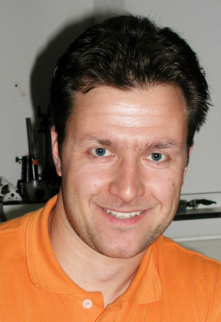Spontaneous-emission rates of quantum dots and dyes controlled with photonic crystals
Promotion Date: 2 November 2006
| In my thesis I describe experimental work in which effects of photonic crystals on spontaneous emission of light from quantum dots and organic dyes were studied. The studied quantum dots are very small particles, of size of several nanometers, made from CdSe semiconductor. When a quantum dot or a dye molecule is excited, it loses its energy by emitting a photon. This process is called spontaneous emission. It was predicted that the rate with which the quantum dots or the dyes emit light can be completely controlled in photonic crystals. In our group we have experimentally demonstrated for the first time that photonic crystals control the rate of spontaneous emission. When quantum dots are put into a photonic crystal, their emission rate is strongly increased or decreased, which is determined by the lattice spacing of the crystal. |
What is your thesis about?
In my thesis I describe experimental work in which effects of photonic crystals on spontaneous emission of light from quantum dots and organic dyes were studied. The studied quantum dots are very small particles, of size of several nanometers, made from CdSe semiconductor. When a quantum dot or a dye molecule is excited, it loses its energy by emitting a photon. This process is called spontaneous emission. It was predicted that the rate with which the quantum dots or the dyes emit light can be completely controlled in photonic crystals. In our group we have experimentally demonstrated for the first time that photonic crystals control the rate of spontaneous emission. When quantum dots are put into a photonic crystal, their emission rate is strongly increased or decreased, which is determined by the lattice spacing of the crystal. In other words, the quantum dots generate more or, when necessary, less light compared to the same dots outside the photonic crystal.
So in fact you generate energy?
Yes. This property of photonic crystals is very important, for instance, for development of lasers or other light emitting devices. It is also important for enhancement of the efficiency of solar cells. And if we look further, we can even start thinking of quantum computers. But that is still a long way to go. However, the improved efficiency of lasers and solar cells is not.
The challenge for industry is to produce photonic crystals on a large scale.
Photonic crystals have been there for a while. What was new about your research?
In our group we managed to synthesize photonic crystals with the strongest photonic properties in the range of visible light. We also doped our crystals with a new type of light sources, quantum dots, and, what is the most important, experimentally demonstrated a considerable modification of emission rates.
How do you dope photonic crystals with the quantum dots?
Initially the dots are suspended in an organic solution, chloroform for instance. Then the photonic crystals, which are of millimeter size, are put into the suspension with the quantum dots. The crystals have voids containing air, and after some time the quantum dots take up the space in the voids. Then the crystals are taken out of the suspension, the chloroform evaporates, and the dots precipitate on the internal surfaces of the photonic crystals. To detect emission from the dots, which in our experiments emit light of orange color, we excite them with photons of higher energy, with blue light.
Where are you from?
I am from St Petersburg, Russia.
What brought this university to your notice?
When I finished my bachelor studies I decided to continue my studies abroad and went to Germany. There, in Christian-Albrechts University of Kiel I studied materials science. |
Then I was on a search for a PhD position. What I liked about the Dutch universities is that most of the groups have clear websites, in English, giving a clear idea about what is going on in the groups. I applied and from my present supervisor (Prof. Willem Vos) received a quick answer, and he invited me for an interview.
What did you like best about your PhD research?
It is difficult to make such a distinction. I can say that I liked being Ph.D. student as a whole. During the last four years I have been working in a very friendly atmosphere; I learned a lot, and not only about my subject but also about how to present my work. And I even managed to learn the Dutch language.
Did you experience any setbacks?
No, not really, it went quite smoothly.
What are your future plans?
I am looking for a new job, preferably in industry. I would like to stay in this country: I got used to it and even do not complain about the rainy weather. In the region where I come from it is even worse.
For the summary of the thesis, click here.

